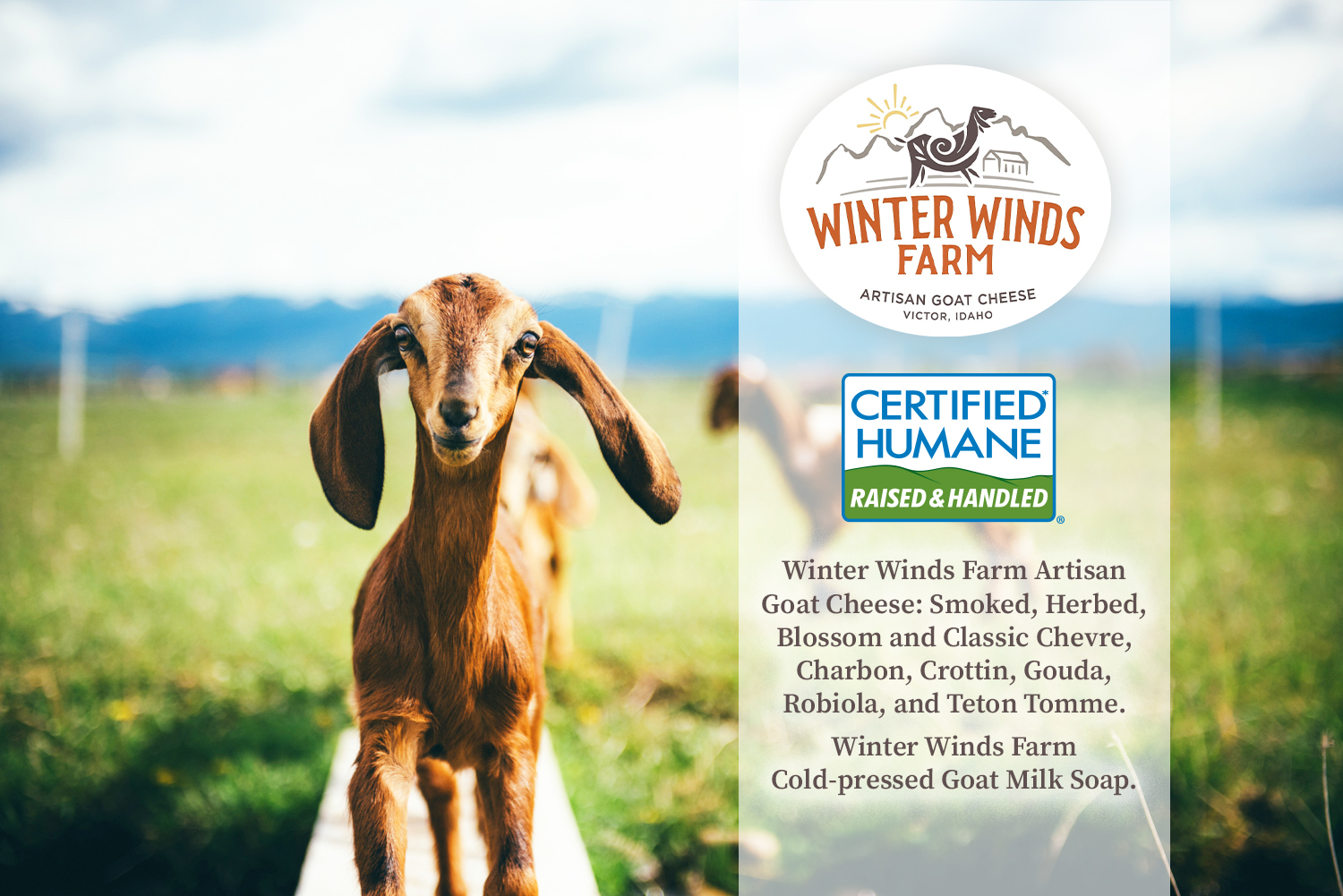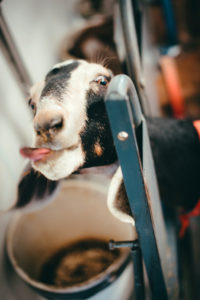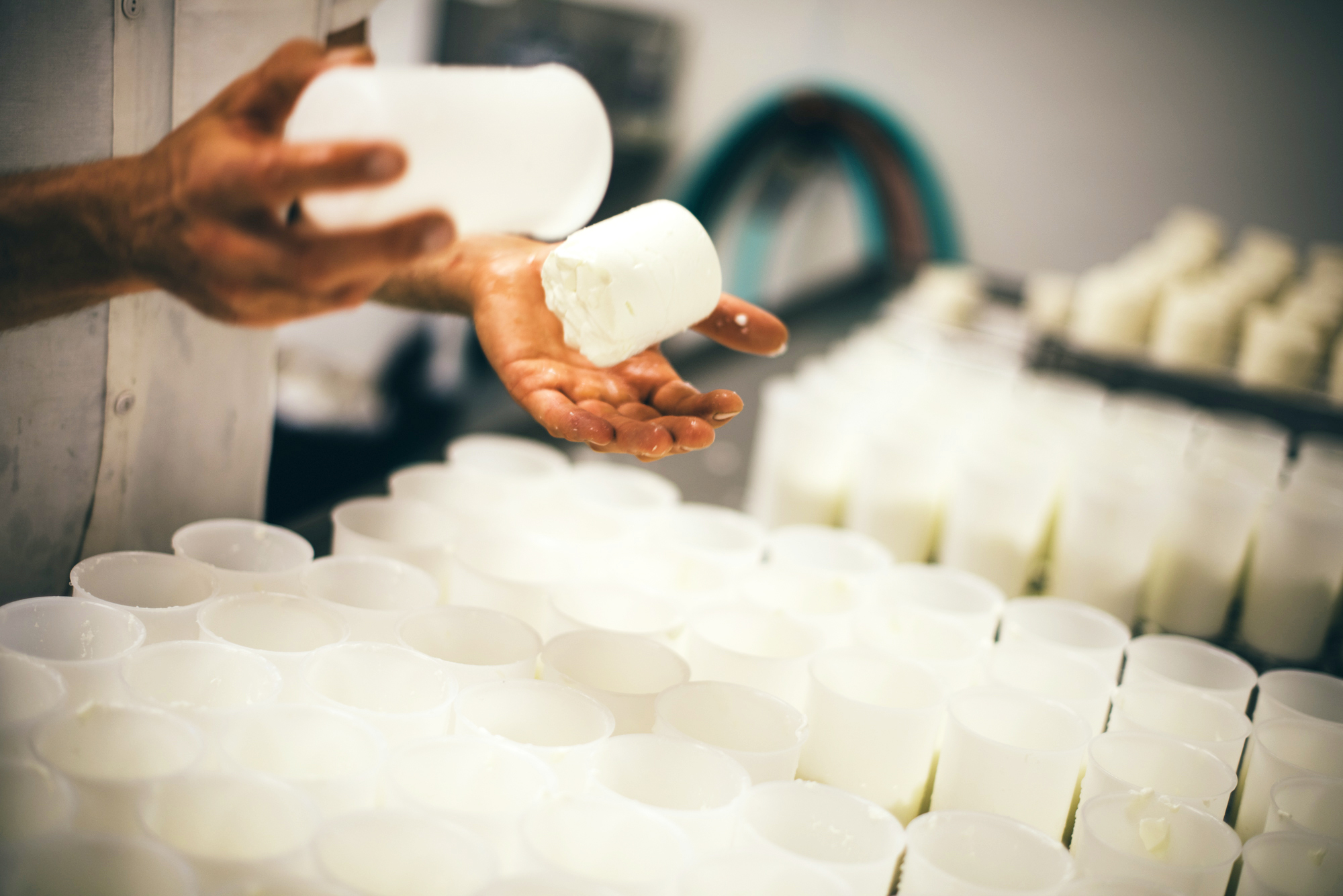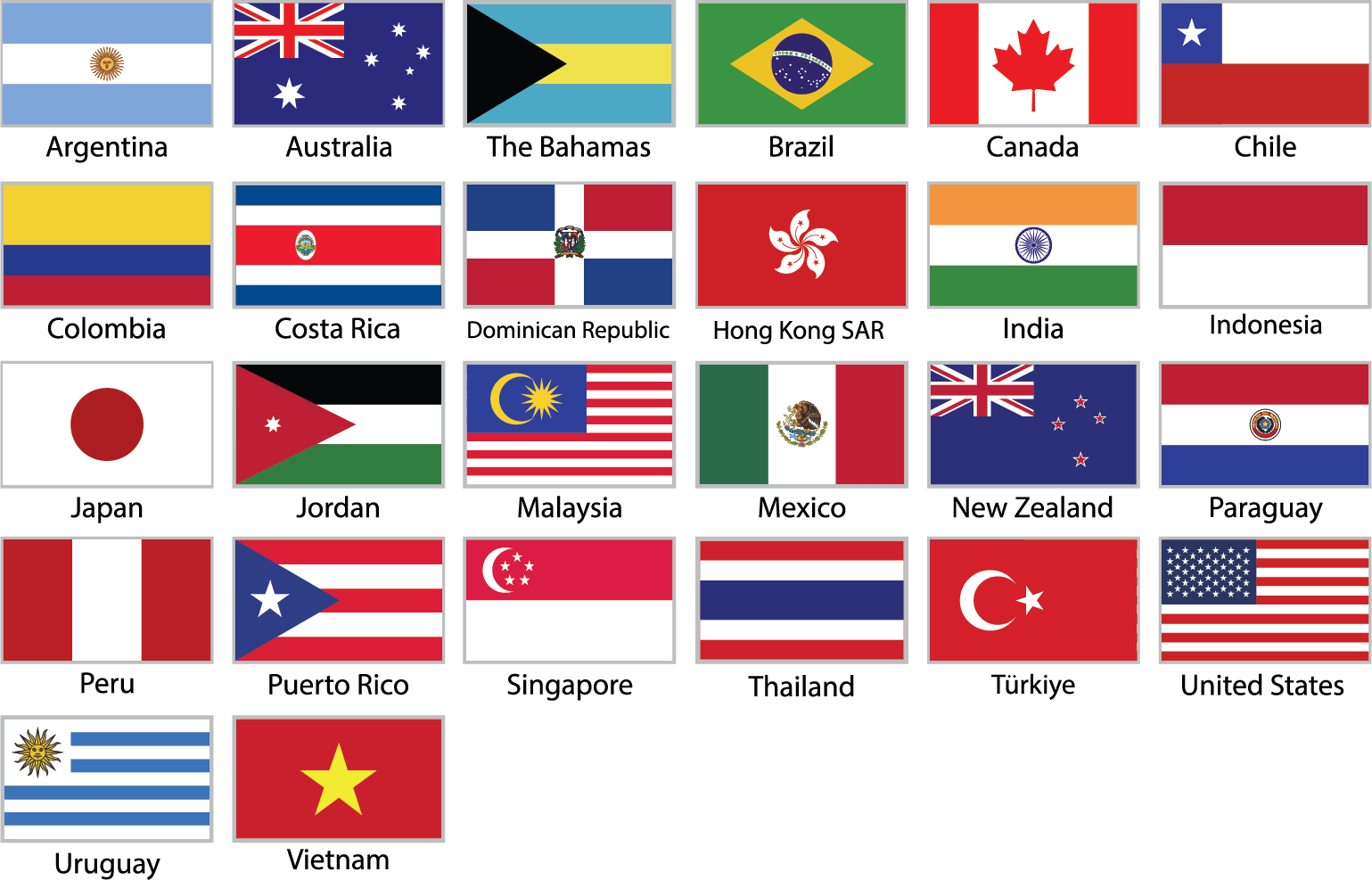
Welcome to the, “quiet side,” of the Teton Mountains, home to Winter Winds Farm, a Certified Humane® producer of Artisan Goat Cheese and Cold-pressed Goat Milk Soap. Nestled in southern end of the Teton Valley lies Victor, Idaho, namesake of a famous postal carrier who would deliver mail over the Teton Pass to Jackson Hole, Wyoming.
“We met on the Washington, DC Ultimate Frisbee circuit through mutual friends,” writes Jessica Konrath, partner and junior cheesemaker at Winter Winds Farm. “Always planning to move out West to be closer to Mark’s family, we were excited to discover the opportunity to purchase Winter Winds Farm.”
 A native Idahoan, Mark Farmer, Chief Farming Officer of Winter Winds Farm, spent over a decade working in Washington, DC. Before meeting Jessica, Mark writes that, “he never would have thought that he would move back to Idaho to raise goats and make cheese, but her passion for goats and love of cheese is infectious.”
A native Idahoan, Mark Farmer, Chief Farming Officer of Winter Winds Farm, spent over a decade working in Washington, DC. Before meeting Jessica, Mark writes that, “he never would have thought that he would move back to Idaho to raise goats and make cheese, but her passion for goats and love of cheese is infectious.”
Together with Senior Cheese Maker Lacey McNeff, Winter Winds Farm proudly producers Certified Humane® goat milk products, available locally in markets, stores, and restaurants.
In addition to artisan products produced year- round, Winter Winds Farm also offers seasonal tours, event space, and encourages visitors to take part in a unique hircine experience: Goat Snuggle Sessions. As Winter Winds Farm writes, “Why Snuggle Sessions you ask? Goats are very social and curious animals. When they aren’t running, jumping, bucking, and playing with each other they love to stay warm in cuddle piles or in the arms and laps of visitors. Snuggle sessions are an excellent way to help socialize the kids and teach them that people are awesome.”
For more information about products, tours and events, or to book your Goat Snuggle Session, visit the farm at WinterWindsFarm.com.
To view photos of Goat Snuggle Sessions, follow Winter Winds Farm on Instagram and Facebook.




Posted: October 1, 2021 by Certified Humane®
Pingyao Weihai Ecological Agriculture
Pingyao Dongyoujia farm was first equipped with the cage free facilities, raising about 20,000 cage free birds in 2016. Once the cage free system was in use and chickens could move and feed freely, Weihai Ecological Agriculture Co., Ltd saw an improved performance of egg production. Additionally, the chickens raised in their new cage free system were more vigorous and had stronger disease resistance.
At that time, cage free birds only accounted for 8% of total production. Nanzhanwan farm is currently building 5 cage free chicken barns, and each will house 30,000 egg laying hens. Now as a producer of Certified Humane® eggs, Weihai Ecological Agriculture Co., Ltd is a stronger competitor in the marketplace where many multinational companies are committed to using cage-free eggs.
Posted: September 7, 2021 by Certified Humane®
Happy Eggs (Hainan)
Happy Eggs (Hainan) Agriculture Development Co., Ltd Jiangsu Branch
Since 2015, Wang Weisheng and his team have visited dozens of laying hens breeding factories and found that small and medium-sized farmers have simple facilities, and that widespread use of antibiotics is common practice. Wang Weisheng and his team hope to use mobile Internet technology to help farmers raise chickens, promote humane husbandry practices, and let consumers eat, “non-resistant,” eggs. In November 2016, the brand, “Happy Egg,” was officially born. In the follow year, July of 2017, Happy Egg and Dr. Jianming Tong set up a joint venture laboratory to promote the development and application of A50 feed technology. In 2020, Happy Egg landed in Baisha, Hainan, China’s largest welfare farm. In November of the same year, a chicken coop project was launched in Nantong, Jiangsu Province. At present, Happy Egg is spreading the concept and practice of cage-free eggs to individuals, families, and businesses, who support the concept of farm animal welfare.
As a participant and advocate of Certified Humane® laying hens in China, Happy Egg also assumes responsibility educating local markets. In addition to the construction of the welfare farm, Happy Egg will also build a welfare farming museum to share the experience of interaction between farms and consumers. The goal is to popularize welfare farming to Chinese consumers and share relevant experiences among farmers to make Certified Humane® practices the mainstream farming method.
At present, Happy Eggs sells online in Jingdong self-run stores nationwide, and offline in the Beijing area, such as Hema Xiansheng, Ding Dong Mai Cai, Cuixiangguomei, guoduomei, Weifang Jia Le Jia chain supermarket and other grocery chain channels. Learn more about Happy Eggs by visiting http://www.kuailededan.com/
Posted: July 21, 2021 by Certified Humane®
Farm Fresh – Malaysia
First Certified Humane® Dairy company in asia
Introducing Farm Fresh®, the first dairy company in Asia to be awarded the internationally recognized Certified Humane® certification. As the owner and operator of four dairy farms in Malaysia, Farm Fresh® was drawn to the Certified Humane® Program because Certified Humane® standards are closely in-line with their own commitment to animal welfare and sustainability.
“We spare no efforts to ensure that they have an amazing experience living with us,” says Managing Director, Loi Tuan Ee. Cows are fed a nutritious diet primarily composed of fresh grasses harvested at peak ripeness. To maintain sustainable land-use practices, soil is fertilized with the farm’s own organic compost and irrigated with wastewater. “We invested in world-class infrastructure for milking, housing, and cooling our cows” says Loi Tuan Ee. “Since heat stress is common in the region, we focus on sufficient ventilation as well as soakers for effective evaporative cooling.”
In Malaysia’s tropical environment, heat stress is a regular concern for farmers. Farm Fresh® raises Australian Friesian Sahiwal cattle, a breed developed in Australia that is especially suited to hot and humid climates. “Our Certified Humane® husbandry practices allow us to raise cows that are more resilient and comfortable in the heat and humidity,” says Azmi Zainal, Chief Operating Officer. “Effective herd health management is our priority and we believe that prevention is the best cure,” adds Group Senior Farm Manager, Jacob Mathan. Not only does Farm Fresh® carry out routine screenings and prevention strategies, all farms operate a pedicure unit to pamper and care for cows’ hooves. “We want to ensure that animals under our care are always healthy and happy.”
For more information, please visit www.farmfresh.com.my
Posted: July 13, 2021 by Certified Humane®
Gemperle Family Farms
Gemperle Family Farms is now one of the leading producers of Certified Humane®, organic eggs in Northern California. The second generation of family members, along with a talented team of employees, lead the organization while the third generation family members are starting to learn the nuts and bolts of the business as well.
Since the 1990’s, Gemperle Family Farms has been converting barns to aviary style cage free production where hens are free to perch, socialize, dust bathe and nest. Today, the farm proudly produces Certified Humane® brown and white eggs, organic eggs, and Omega-3 specialty eggs.
Gemperle family values encompass strong stewardship, caring for the environment, their hens, their customers, and community. These values are the core of their farming philosophy. All of the hen houses are surrounded by sustainably farmed almond orchards. Their egg farming practices include conservation of water, energy, land, and resources. Most Gemperle Family Farms eggs are sold within a 100 miles radius of the farm.
Mike Gemperle, VP of Farming Operations, states, “Our land, air and water belong to future generations, and this philosophy is at the heart of each decision we make. This same stewardship philosophy has directed us towards Certified Humane® with some of the highest animal welfare standards in the industry. That is important to us and our customers.”
Learn more about Gemperle Family Farms at : www.gemperle.com
Posted: May 27, 2021 by Certified Humane®
Winter Winds Farm, Victor, Idaho
Welcome to the, “quiet side,” of the Teton Mountains, home to Winter Winds Farm, a Certified Humane® producer of Artisan Goat Cheese and Cold-pressed Goat Milk Soap. Nestled in southern end of the Teton Valley lies Victor, Idaho, namesake of a famous postal carrier who would deliver mail over the Teton Pass to Jackson Hole, Wyoming.
“We met on the Washington, DC Ultimate Frisbee circuit through mutual friends,” writes Jessica Konrath, partner and junior cheesemaker at Winter Winds Farm. “Always planning to move out West to be closer to Mark’s family, we were excited to discover the opportunity to purchase Winter Winds Farm.”
Together with Senior Cheese Maker Lacey McNeff, Winter Winds Farm proudly producers Certified Humane® goat milk products, available locally in markets, stores, and restaurants.
In addition to artisan products produced year- round, Winter Winds Farm also offers seasonal tours, event space, and encourages visitors to take part in a unique hircine experience: Goat Snuggle Sessions. As Winter Winds Farm writes, “Why Snuggle Sessions you ask? Goats are very social and curious animals. When they aren’t running, jumping, bucking, and playing with each other they love to stay warm in cuddle piles or in the arms and laps of visitors. Snuggle sessions are an excellent way to help socialize the kids and teach them that people are awesome.”
For more information about products, tours and events, or to book your Goat Snuggle Session, visit the farm at WinterWindsFarm.com.
To view photos of Goat Snuggle Sessions, follow Winter Winds Farm on Instagram and Facebook.